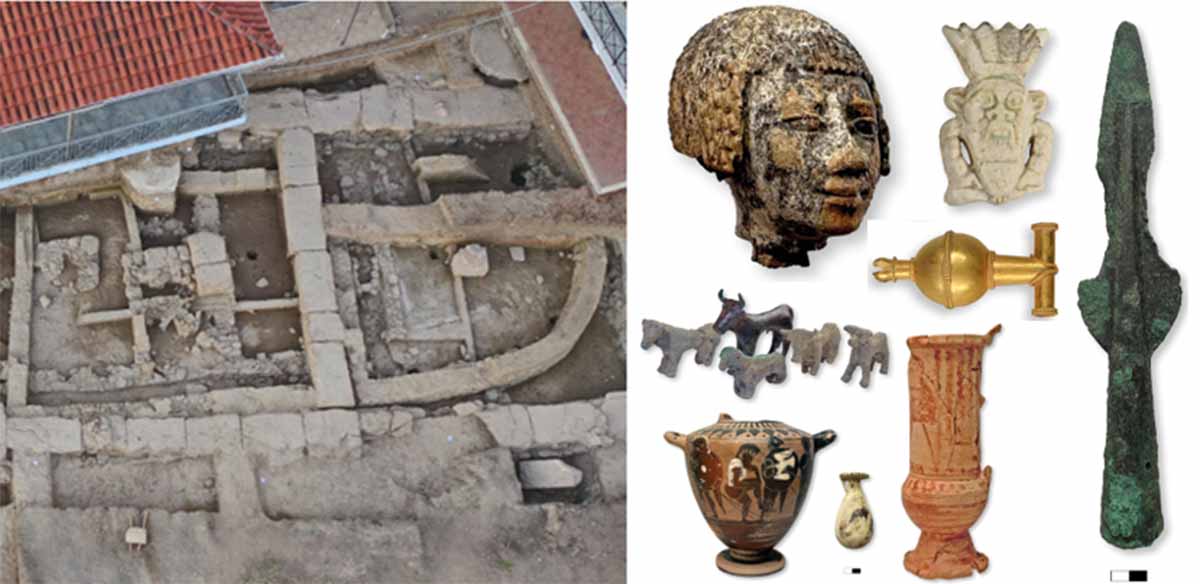Glorious 7th Century BC Artemis Temple Uncovered on Greek Island of Euboea
Excavating a temple at the Artemis Amarynthos sanctuary on the Greek island of Euboea, a collaborative four-year effort between Swiss and Greek archaeologists has uncovered a beautiful temple of Artemis, dating back to the 7th century BC. Its size exceeded initial expectations, measuring an impressive 34 meters (111.5 feet) in length, or 100 feet in the ancient Greek measurement system, a "perfect" measurement encountered in other monuments from the same era.
The temple revealed certain surprises to the archaeologists, as its floorplan turned out to be apsidal (with a semicircle apse at one end), a rarity for this period.

The full length of the Artemis Amarynthos temple shown here is notable at 34 meters (111.5 feet). (Swiss School of Archaeology in Greece)
Similar to previous years, the recent excavations brought to light numerous artifacts - vases, weapons, jewelry, amongst others.
A finely chiseled ivory head with Egyptian features was among the discoveries, which has been restored with great effort after being initially unrecognizable, according to a press release by The Swiss School of Archaeology in Greece.
- Don’t Mess with the Chaste Huntress and Greek Goddess Artemis
- Britomartis: The Original Virgin Huntress

An ivory head recently found at the Artemis Amarynthos temple has Egyptian features. (Swiss School of Archaeology in Greece)
After years of intensive fieldwork and discoveries, the collected data is now being utilized. An international team of specialists, including archaeozoologists, archaeobotanists, experts in microscopic analysis of excavation layers, pottery specialists, and architects are involved.
Sanctuary of Artemis: A Fire, A Restoration, An Animal Sacrifice Cult?
The site displays evidence of a fire, suggesting that the "100-foot" temple suffered partial destruction in the second half of the 6th century BC. It underwent temporary restoration with mud-brick walls before being entirely replaced by a new building by the end of the century.
Deep trial trenches have uncovered remnants from earlier periods, including a potential 9th or 8th century BC building, bronze animal figurines, and a terracotta bull's head from the late Bronze Age. Although exploration of these ancient levels is in its early stages, the findings affirm the roots of the Artemis cult at Amarynthos, extending into prehistory.

Some of the large variety of offerings and jewelry that have been found, including several bulls. (ESAG)
In the practice of traditional animal sacrifices, the ritual unfolded with the designated animal being ceremoniously led in procession to the altar. Once at the altar, the animal would be slaughtered as part of the religious offering. Following the sacrifice, the carcass underwent butchering, and specific parts such as internal organs, bones, and other inedible portions were set ablaze.
This act of burning represented the deity's share or portion, signifying the sacred nature of the offering. The remaining edible parts of the animal might be utilized in communal feasts or distributed among the worshippers, depending on the cultural and religious customs associated with the particular sacrificial practice. This ritual was deeply ingrained in various ancient religious traditions as a means of establishing a connection between the worshippers and the divine realm.

The sacrificial altar at the Artemis Amarynthos temple, Euboea. (ESAG)
Ancient Ritual Structure
Situated at the base of a hill occupied since the Bronze Age, the sanctuary has revealed imposing walls from the 3rd millennium BC, possibly part of a fortification system. Amarynthos' existence in the Mycenaean period is supported by Mycenaean palace archives at Thebes in Boeotia. The remains of prehistoric Amarynthos, visible during the sanctuary's development, fueling tales of a heroic past akin to those in Homeric epics, reports The Heritage Daily.
An extensive survey is underway in the Amarynthos region to understand how the sanctuary integrated into the ancient landscape, studying the natural environment, settlement distribution, agricultural areas, cemeteries, quarries, and the communication network, including a "Sacred Way" linking the sanctuary to the ancient city of Eretria.
- The Grand and Sacred Temple of Artemis, A Wonder of the Ancient World
- Spectacular Statuettes of Apollo and Artemis in Crete

Apollo and Artemis on a Greek cup from about 470 BC. Apollo, who was the Archer, is on the left. Artemis, the huntress, is shown with the bow. (Briseis Painter/Public domain)
Artemis: Greek Goddess of the Hunt
Artemis, a central figure in Greek mythology, is revered as the goddess of the hunt, wilderness, and wild animals. The daughter of Zeus and Leto, with her twin brother being Apollo, she is known for her prowess as an archer and her role as the protector of the hunt, often depicted with a bow and arrows. Artemis is also recognized as a virgin goddess, symbolizing her commitment to chastity.
In addition to her association with the moon, where she is referred to as the "torch-bringer," Artemis is considered a guardian of women and children, providing protection and assistance in childbirth.
The sanctuary of Artemis Amarysia represents a specific cult site dedicated to her worship.
Revered widely in ancient Greece, Artemis played a significant role in various myths and stories, including her involvement in the Trojan War. Her influence extended to different regions, with numerous cults and festivals dedicated to her worship, making her an integral part of ancient Greek religious and cultural traditions.
Top image: Left; the Artemis Amarynthos temple, Right; an array of artifacts found at the site. Source: Swiss School of Archaeology in Greece
By Sahir Pandey
References
Athens Bureau. 2024. Evia: 2,600-year-old temple unearthed in Artemis sanctuary excavation – See the photos. Available at: https://greekcitytimes.com/2024/01/10/evia-temple-artemis-sanctuary/.
Milligan, M. 2024. Excavation of Artemis temple reveals evidence of animal sacrifices. Available at: https://www.heritagedaily.com/2024/01/excavation-of-artemis-temple-reveals-evidence-of-animal-sacrifices/150230.
Jan 2024. A 100-foot temple for Artemis. Swiss School of Archaeology in Greece. Available at: https://www.esag.swiss/amarynthos2023/

















